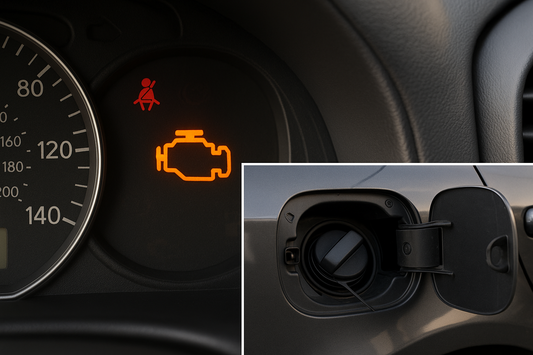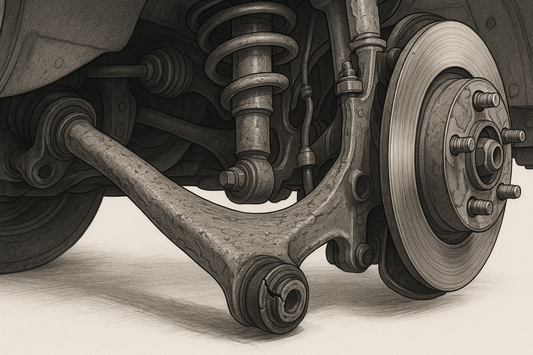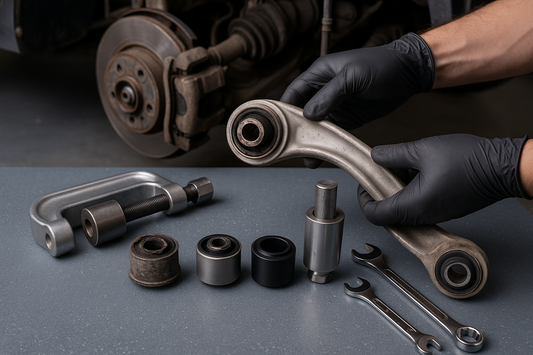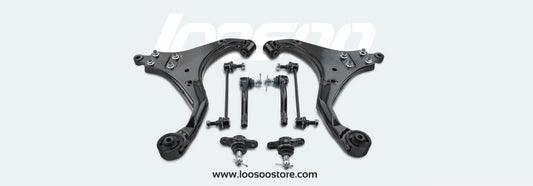Your car’s braking system is non-negotiable for safety—and the brake pads are its heart. When upgrading or replacing them, one of the biggest decisions is choosing between ceramic brake pads and semi metallic brake pads. Both have strengths, but which is right for your driving habits, budget, and vehicle?
In this guide, we’ll break down the key differences between ceramic and semi metallic brake pads, their pros and cons, and how to pick the best option. We’ll also highlight Loosoo—trusted by mechanics for high-performance, durable brake pads—so you can make an informed choice.
What’s the Difference: Ceramic vs Semi Metallic Brake Pads?
Brake pads work by clamping against the rotor to slow your car. Their performance depends on the friction material they’re made of:
Ceramic Brake Pads: Quiet, Clean, and Gentle
Ceramic pads are made from ceramic fibers, copper strands, and bonding resins. They’re designed for smooth, low-noise operation.
Semi Metallic Brake Pads: Tough, Heat-Resistant, and Durable
Semi metallic pads blend steel, iron, or copper fibers (30–70% metal) with friction materials. They’re built for high heat and heavy use.

Key Factors to Compare
Let’s dive into what matters most for drivers: noise, dust, lifespan, and performance.
1. Noise: Ceramic = Quiet, Semi Metallic = Occasional Squeal
- Ceramic: Known for near-silent braking. The soft ceramic fibers reduce vibration, so they rarely squeal—ideal for daily commuters who value peace and quiet.
- Semi Metallic: Metal fibers can create more friction noise, especially when cold. Squealing is possible, though modern designs (like Loosoo’s) minimize this with anti-rattle shims.
Real-World Example: A family SUV driven daily in stop-and-go traffic will likely prefer ceramic pads to avoid annoying brake noise.
2. Dust: Ceramic = Clean Wheels, Semi Metallic = More Grime
- Ceramic: Produce fine, light-colored dust (tan/gray) that doesn’t stick to wheels. Your rims stay cleaner longer—great for drivers who hate scrubbing brake dust.
- Semi Metallic: Generate darker, coarser dust (black/brown) that clings to wheels. Expect more frequent wheel cleaning.
Pro Tip: If you drive a luxury car with alloy wheels, ceramic pads save time and keep your wheels looking sharp.
3. Lifespan: Semi Metallic = Longer in Heavy Use, Ceramic = Consistent
- Ceramic: Last 30,000–70,000 miles, depending on driving. They wear evenly but may degrade faster in extreme heat (e.g., mountain driving).
- Semi Metallic: Withstand high temperatures better, lasting 40,000–80,000 miles. Ideal for towing, off-roading, or frequent highway driving.
Loosoo Insight: Loosoo’s semi metallic pads use high-grade steel fibers that resist wear, extending lifespan by 15% vs. generic brands.
4. Heat Resistance: Semi Metallic Shines in Extreme Conditions
- Ceramic: Perform well in moderate heat (city driving) but may “fade” (lose stopping power) in extreme temps (e.g., downhill braking, track days).
- Semi Metallic: Dissipate heat faster thanks to metal fibers, making them better for heavy-duty use (towing, racing, or hilly terrain).
Example: A pickup truck hauling a trailer up steep hills will rely on semi metallic pads to avoid brake fade.
5. Cost: Ceramic = Premium, Semi Metallic = Budget-Friendly
- Ceramic: $50–$120 per axle (higher due to premium materials).
- Semi Metallic: $40–$90 per axle (more affordable for frequent replacements).
Note: Ceramic pads may save money long-term by reducing rotor wear (see below).
6. Rotor Wear: Ceramic = Gentle, Semi Metallic = More Aggressive
- Ceramic: The soft material glides over rotors, minimizing scoring. This extends rotor life by 20–30% vs. semi metallic.
- Semi Metallic: Metal fibers can scratch rotors over time, requiring more frequent rotor resurfacing or replacement.

Which Should You Choose? Match to Your Driving Style
Choose Ceramic If:
- You drive a sedan, SUV, or luxury car for daily commuting.
- You value quiet brakes and clean wheels.
- You rarely tow, race, or drive in mountainous areas.
Choose Semi Metallic If:
- You drive a truck, van, or performance car (e.g., sports cars, off-roaders).
- You tow trailers, drive on hills, or need consistent stopping power in heat.
- You’re on a budget and don’t mind cleaning wheels more often.
Why Loosoo Brake Pads Stand Out
Not all brake pads are created equal. Loosoo, a brand trusted by professional mechanics, designs pads for real-world performance:
- Ceramic Pads: Use aerospace-grade ceramic fibers for ultra-quiet operation and 30% less dust than competitors.
- Semi Metallic Pads: Blend 45% steel fibers with anti-fade compounds, tested to handle 1,200°F (650°C) without losing stopping power.
- Vehicle-Specific Fit: Loosoo pads are engineered for exact rotor contact, reducing noise and ensuring even wear.
FAQ: Common Questions About Brake Pads
Q: Can I mix ceramic and semi metallic pads?
A: No. Mixing types creates uneven braking force, risking accidents. Stick to one type per axle.
Q: How do I know when to replace brake pads?
A: Listen for squealing, grinding, or a soft brake pedal. Check pad thickness (replace if <3mm).
Q: Do ceramic pads work in cold weather?
A: Yes! Loosoo’s ceramic pads include copper strands to improve cold-weather performance, so they bite quickly even at 20°F (-7°C).
Q: Are semi metallic pads bad for my rotors?
A: They can wear rotors faster than ceramic, but modern designs (like Loosoo’s) use rounded metal fibers to minimize scoring.
Final Thoughts: Safety First, Then Style
Whether you choose ceramic or semi metallic brake pads, prioritize safety and performance over cost. Ceramic pads offer quiet, clean braking for daily drivers, while semi metallic pads handle heat and heavy use better.










